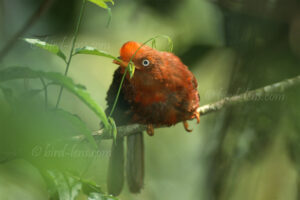 A beautiful day announces itself with a perfect starry sky. So I can really throw myself into the adventure. First I try my luck with the Nikon Nikkor AF-I 4.0/ 600 on the Nikon F 5 set up on the fruiting single tree on the slope where I couldn’t find anything yesterday. I’ve barely taken my position – aligning the lens so that the first rays of morning sun shine on a particularly beautiful branch with fruit – when I hear the first voices from the forest. Now it’s time to properly equip the shelter with a camouflage tent and a Gitzo tripod. A bird comes flying in from a completely different direction than I expected. That then means rescheduling. But nothing is impossible – at least for an adult Andean Cock-of-the-Rock (Rupicola peruviana). I photographed it with my Metz MZ-5 and telephoto flash attachment in normal mode without correction and only the last 2 photos in rear flash mode (2nd shutter curtain) with -1.0 correction.
A beautiful day announces itself with a perfect starry sky. So I can really throw myself into the adventure. First I try my luck with the Nikon Nikkor AF-I 4.0/ 600 on the Nikon F 5 set up on the fruiting single tree on the slope where I couldn’t find anything yesterday. I’ve barely taken my position – aligning the lens so that the first rays of morning sun shine on a particularly beautiful branch with fruit – when I hear the first voices from the forest. Now it’s time to properly equip the shelter with a camouflage tent and a Gitzo tripod. A bird comes flying in from a completely different direction than I expected. That then means rescheduling. But nothing is impossible – at least for an adult Andean Cock-of-the-Rock (Rupicola peruviana). I photographed it with my Metz MZ-5 and telephoto flash attachment in normal mode without correction and only the last 2 photos in rear flash mode (2nd shutter curtain) with -1.0 correction.
I change my location and sit on the path with the tripod and the 600. Maybe I can catch a hummingbird by the picturesque blossoms of the red-blooming flowers. Instead, I hear an Yellow-olive Flycatcher (Tolmomyias sulphurescens) all the time. This gives me the idea to try out my MiniDisk construction with the 7m cable. It actually works quite well; Unfortunately, the olive-crowned broadbill only gets to the right branch for such a short time that I don’t even have time to turn the flash switch to on (if I leave the flash running the whole time, I’ll be completely without flash energy afterwards). I was compensated for this by one – no, several – Andean Cock-of-the-Rock, which had apparently come up the mountain together and then sat down on a horizontal branch right in front of me. I capture him/her in normal mode without correction and in rear flash mode (2nd shutter curtain) with -1.0 correction.
Tunquini Biological Station is – or was – a scientific research station in the Cotapata National Park in the province of La Paz in Bolivia. There is currently no entry for this area on eBird. The next hotspot is Coroico. And Coroico is more of a town, the edges of which extend into open country – with some recommended lodges. In any case, the area above Chailo was an excellent area of the relatively low Yungas forest (approx. 1600 m), which could be accessed with the Tunquini Biological Station. The biological research station has a large bedroom, spacious lounges and cooking facilities, which were available during our stay. We arranged the stay there through Luis Pacheco, who is responsible for scientific work in the reserve. I seem to remember that we followed the sign from the road to Rio Selva Resort. 11 km after the junction we passed Rio Selva and soon reached the small village of Chairo. The new main road now runs very close to Chairo (we were there in 2000). From there you follow the path described. The only path through the forest is the continuation of the Chairo path, but it is good for bird watching in both directions. I almost couldn’t believe that this station – as I was assured many times – had electricity. It later turns out how justified my disbelief was. At some point during our stay, four men come and actually install a hydroelectric power plant that actually supplies a lot of electricity. This meant that both the camera battery and the flash could be charged.
To meet the growing demand for top-of-the-line images of the rarer Palaearctic species, Bird-lens.com strives to expand the range of images of Western Palaearctic birds. Trips to many locations to take pictures of rare western Palearctic birds have been very successful. This nice picture of the blog is just a first impression of what you can find in the gallery in the “Picture Shop” very soon. Please leave a message if bird-lens.com can provide a picture.